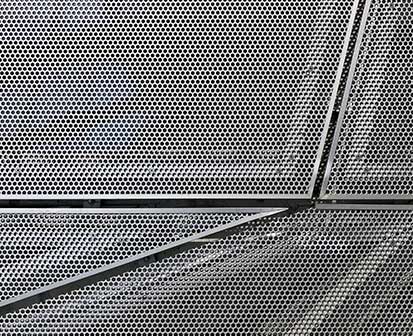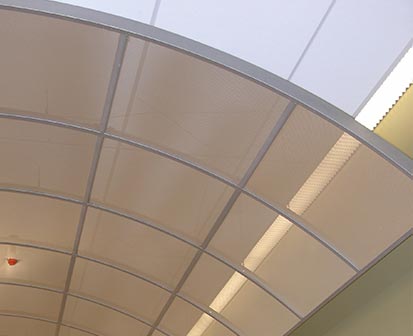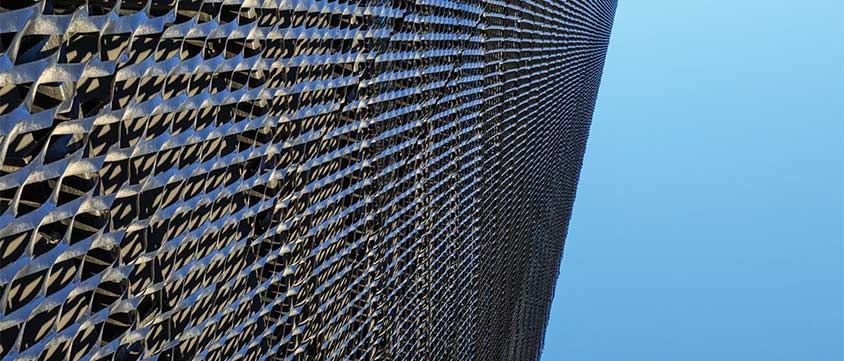Architectural Metal
More than ever, many architects and organizations are realizing how valuable, functional, and effective pre-fabricated metal buildings, panels, and sections can be when trying to combine function and aesthetics for renovations, new expansions, and new buildings. architectural metal mesh, in particular, can help to meet a variety of challenges, such as:
- Creating safe walkways
- Building privacy into open spaces
- Offering designs with aesthetic appeal
- Improved airflow and ventilation
Metalwork solutions combine these features to offer a valuable material and tool to architecture as an industry. Architectural metal mesh offers an ideal solution for structural elements, ornamental designs, panels and sections, and more.
Implementing metal solutions in your architecture will also make your building last longer and be more structurally sound, given the corrosion resistance, low maintenance, structural performance required from architectural expanded metal and architectural perforated metal. Additionally, these products are eco-friendly, sustainable, and offer both shading and reflectivity. When working to lift up ratings and exceed code requirements, metal solutions are often the answer.
Metal products are available in a wide range of custom sizes and shapes. Common materials for architectural applications include:
- Steel
- Aluminum
- Copper
- Brass
- Cold rolled steel
Each metal type provides its own grade and varied beneficial mechanical properties that can address concerns within specific applications. Depending on your specific architectural design challenges, expanded metal or perforated metal may further improve these properties when seeking solutions to architectural challenges. Expanded metal is lossless and gains strength from the expansion process, while perforated metal involves punching holes in the material.


Advantages of Metal Fabrication
There are a wide range of advantages provided by the metal fabrication processes. These include:
High strength
Metal grades are generally stronger, harder, and more durable than other materials. When incorporated into architectural designs, they provide high strength and stability, offering more options to the architect
Heat resistance
Given their higher melting points, metals are less likely to degrade even as temperatures climb.
Versatility
With many styles, sizes, patterns, and materials available, metal fabrication is one of the most versatile options available for architecture. A custom metal can be selected to suit the specific needs of the application.
Affordability
In many long-term and high volume architectural applications, metal offers a cost-effective option, especially for long-term projects or high-volume production.
Architectural Expanded Metal
Expanded metal provides a variety of styles and materials for architectural applications. The openings that characterize expanded metal allow air, light, and sound to pass through, but can be customized to provide more or less of any of those aspects. The high level of customization options makes expanded metal quite versatile and cost-effective.
Expanded metal comes in three types:
- Flattened
- Standard
- Heavy grating
When choosing an expanded metal style, hexagonal or square holes can provide high aesthetic value for architectural applications, while diamond-shaped openings offer superior strength and rigidity over time. Each of these options can be customized so that the function and appearance of your architectural vision remain aligned
The flattened and raised profiles of expanded metal products provide texture and create a desirable three-dimensional look. When combined with glass, concrete, plastics, and other materials, expanded metal can offer a functional and modern appearance while still offering rigidity and strength. When used in outdoor applications, expanded metal holds up against the elements, as it is non-porous and resistance to corrosion. Expanded metal also causes very little wasted material, as the production process loses almost no metal to scrap
When selecting options for architectural expanded metal, clients can choose from:
- Micro meshes
- Light and intermediate options
- Heavy duty
The materials most typically used include steel, aluminum, and copper, with each option offering distinct weight and strength specifications as well as differing aesthetic effects.

Architectural Perforated Metal
Perforated metal can be purchased in many different specifications, with hole size and hole shape being fully customizable. Different gauges and various materials can also be used, making for many distinct products within this larger group of offerings. The advantages of perforated metal are many, but the strongest among them include:
- High strength
- Aesthetic appeal
- Versatility
- Lightweight
- Easy to fabricate/form
Perforated metal has become a popular choice for designers and architects for these reasons. Many uses exist, including applications such as:
- Ventilation
- Ceiling panels
- Building façade work
- Screening
Based on the needs of the application, different hole shapes can easily allow sound and light to pass through, as well as liquid and air in situations that need rainwater to pass through easily or as part of a ventilation system.
Punches and presses can provide a variety of hole patterns in sheet metal, which makes for excellent design flexibility while retaining all the practical, functional advantages of the material. Based on your needs, material choices for perforated metal include
- Copper
- Aluminum
- Stainless steel
- Brass
- Cold rolled steel
Custom perforated metal solutions can meet the needs of nearly any design. For instance, skipped punches in a custom design create gaps and margins across the material perpendicularly. Also, sections of punches can be gagged to create a parallel center margin or rectangles of un-punched metal within the pattern, maintaining the strength of the material while creating a unique design.
Consider the hole size, shape, and function you need from a custom perforated metal solution before meeting with a provider to discuss your order, so you have an idea of what you need from functionality and appearance of your solution.

Architectural Metal Applications
Metal elements, accents, and structures can meet the challenges of a wide variety of architectural applications. These include:
- Architectural fencing
- Building cladding
- Building facades
- Ceiling and wall lighting
- Ceiling panels
- Column covers
- Doors and cabinet doors
- Drive and sidewalk gates
- Facades
- Fire escapes
- In-fill panels
- Interior design
- Interior partitions and barriers
- Light diffusers
- Lighting enclosures
- Lockers
- Office dividers
- Privacy screening
- Radiator covers
- Revolving door grating
- Screening
- Signage
- Sunscreens
- Sunshades
- Topiary wall
- Walkways
- Mezzanines
- Stairways
- Windows
- Door and skylight guards
Ultimately, your architectural application will have its own unique design elements. Speaking with a member of our engineering design team can help you discover the ways in which expanded or perforated metals can solve your architectural challenges while achieving your vision for the spaces you design.
For more information on our expanded metal and perforated metal solutions for architectural applications, please don’t hesitate to contact us or request a quote.








